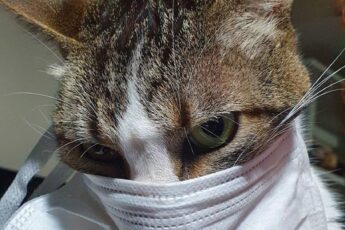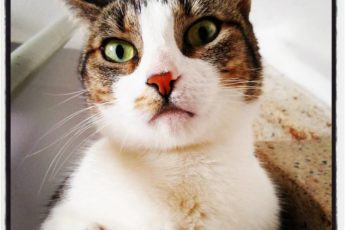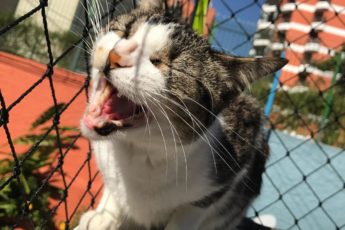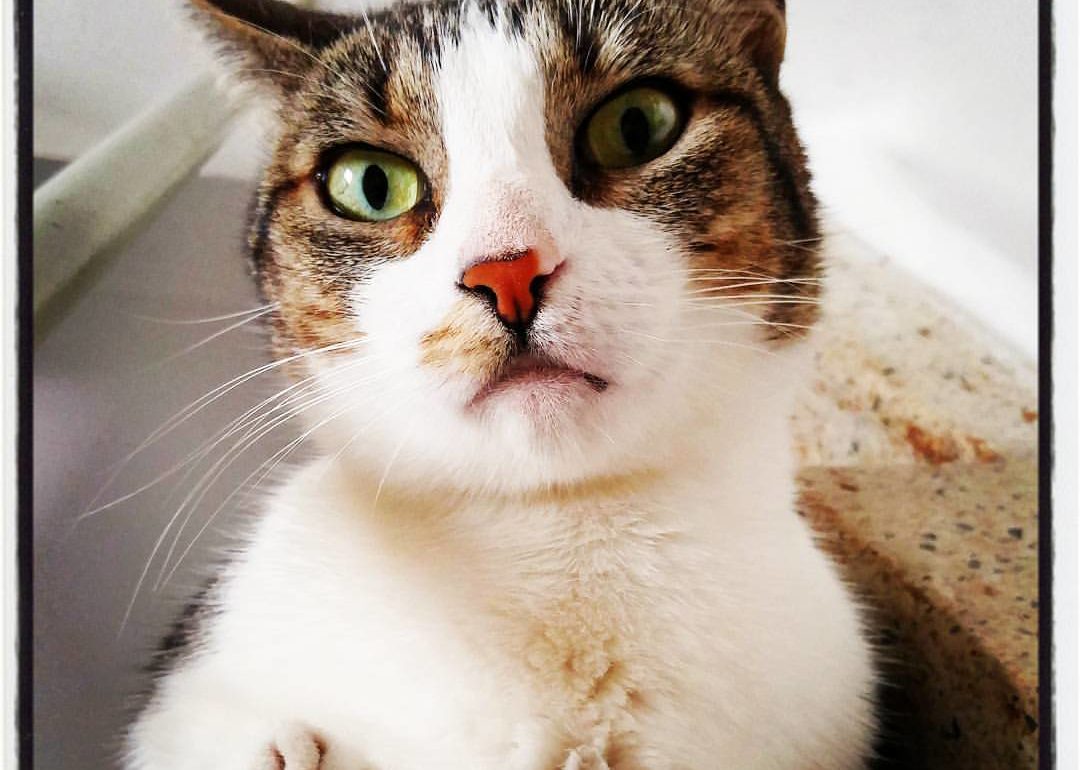
If you follow this blog you already know I have pets – 2 dogs and 5 cats. This post is about one of those cats, Myrtle. She’s FeLV+, like her mother Zuri and her sister Bo.
You might be wondering what FeLV is. It’s an infectious disease caused by a virus that only affects felines. The acronym means Feline Leukaemia Virus. Despite the name, it’s uncommon for FeLV to cause leukaemia. It mostly causes anaemia and positive cats are more susceptible to developing lymphoma.
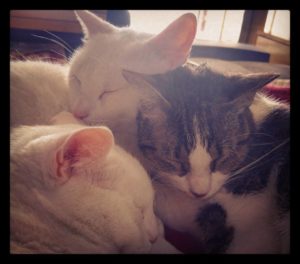 As I said before, I have 3 positive cats at home. Zuri was rescued from the street and I don’t know when she became positive. Myrtle and Bo were born in my house, so I am sure they caught it from Zuri. This may have happened during pregnancy, breastfeeding, or even after, through saliva. My oldest cat, Boris, has lived with them for many years and remains negative. It’s possible he caught the virus, expelled it and became immune. He was already an adult (over 3 years old) and very healthy when I brought Zuri home. My youngest cat, Mori (from Moriarty), was rescued when he was between 8 and 12 months old. As kittens are more susceptible to the virus, I chose to vaccinate him with the V5 vaccine, which prevents against FeLV.
As I said before, I have 3 positive cats at home. Zuri was rescued from the street and I don’t know when she became positive. Myrtle and Bo were born in my house, so I am sure they caught it from Zuri. This may have happened during pregnancy, breastfeeding, or even after, through saliva. My oldest cat, Boris, has lived with them for many years and remains negative. It’s possible he caught the virus, expelled it and became immune. He was already an adult (over 3 years old) and very healthy when I brought Zuri home. My youngest cat, Mori (from Moriarty), was rescued when he was between 8 and 12 months old. As kittens are more susceptible to the virus, I chose to vaccinate him with the V5 vaccine, which prevents against FeLV.
This brings me to the first thing I want to talk about. FeLV is preventable. The vaccine, V5, is not 100% fail-proof, as no vaccine is. But healthy adult cats are already naturally resistant to the virus. If you add the vaccine to that natural protection, it becomes very safe.
 With vaccination, positive and negative cats can live together. So, if one of your cats tests positive, don’t panic! Vaccinate the others and be happy. And if you have negative cats and decide to adopt a positive one, all you have to do is vaccinate the negative ones with the V5 shot before bringing the positive cat home.
With vaccination, positive and negative cats can live together. So, if one of your cats tests positive, don’t panic! Vaccinate the others and be happy. And if you have negative cats and decide to adopt a positive one, all you have to do is vaccinate the negative ones with the V5 shot before bringing the positive cat home.
Now onto Myrtle’s case. On a Wednesday, back in October 2014, she didn’t sleep with me as she normally would. The next few days she seemed quieter, was hiding and wasn’t playing. I had to entice her into the house with treats (Dreamies are like cat cocaine). On Saturday she was very lethargic, even my mother noticed it. On Sunday she was almost dead. She could barely get up. I checked her gums and they were completely white. I called the hospital and told them I had a cat who needed a blood transfusion and I needed to know what the criteria were for choosing a donor. I left home with Myrtle and Boris, my biggest cat, who, luckily, was negative (we only found out after the transfusion had already happened).
Myrtle arrived half dead, and her haematocrit was only 8% – reference values go from 22 to 38%. We proceeded with the emergency transfusion and she was placed in intensive care. We only had enough time to test the compatibility between her and Boris. All other tests were run the next day.
Among the many tests were the snap test for FIV (feline immunodeficiency virus) and FeLV and hers came back positive for FeLV. After getting this result, I tested all my other cats and found out that Zuri and Bo were positive too. Additionally, Myrtle presented with mycoplasma, which is a parasite transmitted by fleas and which attacks and destroys red blood cells, causing anaemia. She was treated for mycoplasmosis after the transfusion and got better, her HT reached 25%. But after about a month, it dropped back to 11%.
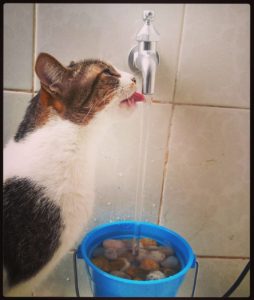 Unlike most of the cases I see, Myrtle didn’t undergo another transfusion, because her lactate test showed her oxygen level was still ok. The vet who was treating her, and who wasn’t a feline specialist, recommended we started treating her with prednisolone, but the dose was low, an anti-inflammatory dose, still enough to raise her ht to 16%. He suspected she already had lymphoma by then because her liver and spleen were swollen.
Unlike most of the cases I see, Myrtle didn’t undergo another transfusion, because her lactate test showed her oxygen level was still ok. The vet who was treating her, and who wasn’t a feline specialist, recommended we started treating her with prednisolone, but the dose was low, an anti-inflammatory dose, still enough to raise her ht to 16%. He suspected she already had lymphoma by then because her liver and spleen were swollen.
We ran fine needle aspiration tests of her liver, spleen and bone marrow and the results were inconclusive. At that point, the vet referred her to a specialist, Dr Camila Ferreiro Pinto, as he didn’t know what else to do.
I’ll forever be thankful to the team that cared for Myrtle and, especially, to Camila. She studied Myrtle’s case for a week and in her first appointment, she already suspected IMHA – immune-mediated haemolytic anaemia. The treatment for this type of anaemia is to suppress the immune system. Might seem counterproductive, as one of the complications of FeLV is a depressed immune system and people will go to lengths to keep their positive cat’s immunity high. But in this case, the opposite must be done. She stopped the antibiotics because her problem wasn’t the mycoplasma, it was her immune system which destroyed her red blood cells. Mycoplasma might have been a trigger, or maybe even FeLV itself was. Her body tried to destroy the virus or the parasite, ‘freaked out’ and started attacking the red blood cells. Typical autoimmune disease.
We started treatment with high doses of prednisolone and within a week her ht was up to 29%. She was taking 10mg per day and she weighed 3.5kg by then. The immunosuppressing dose is between 2 and 4mg per kg. Less than that is merely an anti-inflammatory dose.
Once she was out of the woods, we started a chemotherapy drug, Leukeran. It treats lymphomas, but also blood disorders. And it has fewer side effects than prednisolone. With the combination of drugs, her ht reached 35% and never went back down. That was at the end of December 2014 / beginning of January 2015. Then we started weaning her off the meds, slowly. And I mean extremely slowly! She only stopped all medicines in May 2016, a year and a half later. And she hasn’t had anaemia or taken any medication to treat it since. She was only medicated when she had a root canal done – she managed to break a tooth…
Myrtle is one of the few cases I’ve seen of IMHA being diagnosed early enough for treatment to work. That’s why I always insist on finding out the cause of the anaemia as soon as possible. Had we continued to treat mycoplasma endlessly, she wouldn’t have made it. By the way, mycoplasma simply stopped showing up in her blood test after a few months, even though she wasn’t on antibiotics anymore. It is likely she still has the parasite, but it is under control.
Since a lot of people ask me about her in the Facebook groups about FeLV I have joined, I decided to write this text and leave it here. That way, I can direct people to read this instead of waiting for me to have time to reply to a post or a private message. My wish is that Myrtle’s experience helps other cats because many vets won’t even consider IMHA, especially when some other cause is present (i.e. mycoplasma) and quick, correct treatment is of the essence.
If you find yourself in this situation, my first advice is: don’t panic. FeLV is not a death sentence. I have 3 positive cats who have no symptoms and have been healthy for years. At least 2 of them were born with the disease (or acquired it at a very young age) and 1 of them has presented serious symptoms and has recovered. They’ve all passed the dreaded 3-year post-diagnosis ‘expiration date’ as well.
My second advice is to seek a feline specialist. Cats are not small dogs. It’s important that your vet knows cat diseases well.
 My third advice is to insist with your vet to find out the cause of the anaemia. Don’t ever settle for an answer such as ‘It’s just what FeLV is like’. Even in FeLV+ cats, anaemia can be caused by mycoplasma, kidney disease, internal bleeding, cancer, or the immune system itself. Only by knowing exactly what is causing it, you will be able to treat it correctly. And no test will say it’s IMHA. It’s differential diagnosis. When the mycoplasma treatment no longer worked for Myrtle and all other tests were inconclusive, Camila studied her history and realized the most likely cause was IMHA – that’s why you need a vet who knows cats well.
My third advice is to insist with your vet to find out the cause of the anaemia. Don’t ever settle for an answer such as ‘It’s just what FeLV is like’. Even in FeLV+ cats, anaemia can be caused by mycoplasma, kidney disease, internal bleeding, cancer, or the immune system itself. Only by knowing exactly what is causing it, you will be able to treat it correctly. And no test will say it’s IMHA. It’s differential diagnosis. When the mycoplasma treatment no longer worked for Myrtle and all other tests were inconclusive, Camila studied her history and realized the most likely cause was IMHA – that’s why you need a vet who knows cats well.
My wish is that this story helps you. But if it is not enough, feel free to leave a comment here, send me a message, or contact me on Facebook. Let’s work to demystify FeLV and help positive cats live longer and better lives!

